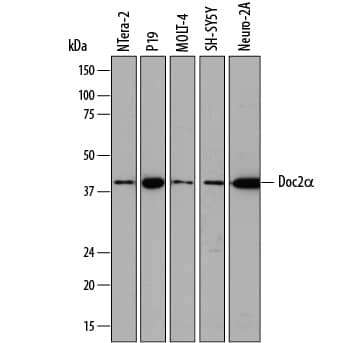Human/Mouse Doc2 alpha Antibody
R&D Systems, part of Bio-Techne | Catalog # AF7904

Key Product Details
Species Reactivity
Validated:
Cited:
Applications
Validated:
Cited:
Label
Antibody Source
Product Specifications
Immunogen
Met1-Lys114 (Gly48Ser)
Accession # Q14183
Specificity
Clonality
Host
Isotype
Scientific Data Images for Human/Mouse Doc2 alpha Antibody
Detection of Human and Mouse Doc2 alpha by Western Blot.
Western blot shows lysates of NTera-2 human testicular embryonic carcinoma cell line, P19 mouse embryonal carcinoma cell line, MOLT-4 human acute lymphoblastic leukemia cell line, SH-SY5Y human neuroblastoma cell line, and Neuro-2A mouse neuroblastoma cell line. PVDF membrane was probed with 2 µg/mL of Sheep Anti-Human Doc2a Antigen Affinity-purified Polyclonal Antibody (Catalog # AF7904) followed by HRP-conjugated Anti-Sheep IgG Secondary Antibody (Catalog # HAF016). A specific band was detected for Doc2a at approximately 40 kDa (as indicated). This experiment was conducted under reducing conditions and using Immunoblot Buffer Group 1.Applications for Human/Mouse Doc2 alpha Antibody
Western Blot
Sample: NTera‑2 human testicular embryonic carcinoma cell line, P19 mouse embryonal carcinoma cell line, MOLT‑4 human acute lymphoblastic leukemia cell line, SH‑SY5Y human neuroblastoma cell line, and Neuro‑2A mouse neuroblastoma cell line
Formulation, Preparation, and Storage
Purification
Reconstitution
Formulation
Shipping
Stability & Storage
- 12 months from date of receipt, -20 to -70 °C as supplied.
- 1 month, 2 to 8 °C under sterile conditions after reconstitution.
- 6 months, -20 to -70 °C under sterile conditions after reconstitution.
Background: Doc2 alpha
DOC2A/Doc2 alpha (Double C2-like domain containing protein alpha) is a 44 kDa (predicted) monomeric member of the C2 domain-containing protein family of molecules. It is expressed in both neurons and mast cells, and appears to serve as an intracellular Ca++ sensor protein that regulates secretory vesicle release. In neurons, Doc2 alpha is normally bound to synaptic vesicles and interacts with Munc13-1 to promote secretory vesicle exocytosis through the cell membrane. In mast cells, a similar process occurs that involves Munc13-4 instead of Munc13-1. Human Doc2 alpha is 400 amino acids (aa) in length. It contains a Mid domain (aa 13-37) that binds Munc13-1, followed by one C2 domain that binds Ca++ and lipid (aa 91-195), and a second C2 domain that binds SNAP25 (253-356). There is one potential alternative start site 16 aa upstream of the standard site. Over aa 1-114, human Doc2 alpha shares 90% aa sequence identity with mouse Doc2 alpha. Human DOC2B is the product of a separate gene, and shares no meaningful aa sequence identity (< 30%) with human Doc2 alpha.
Long Name
Alternate Names
Gene Symbol
UniProt
Additional Doc2 alpha Products
Product Documents for Human/Mouse Doc2 alpha Antibody
Product Specific Notices for Human/Mouse Doc2 alpha Antibody
For research use only
